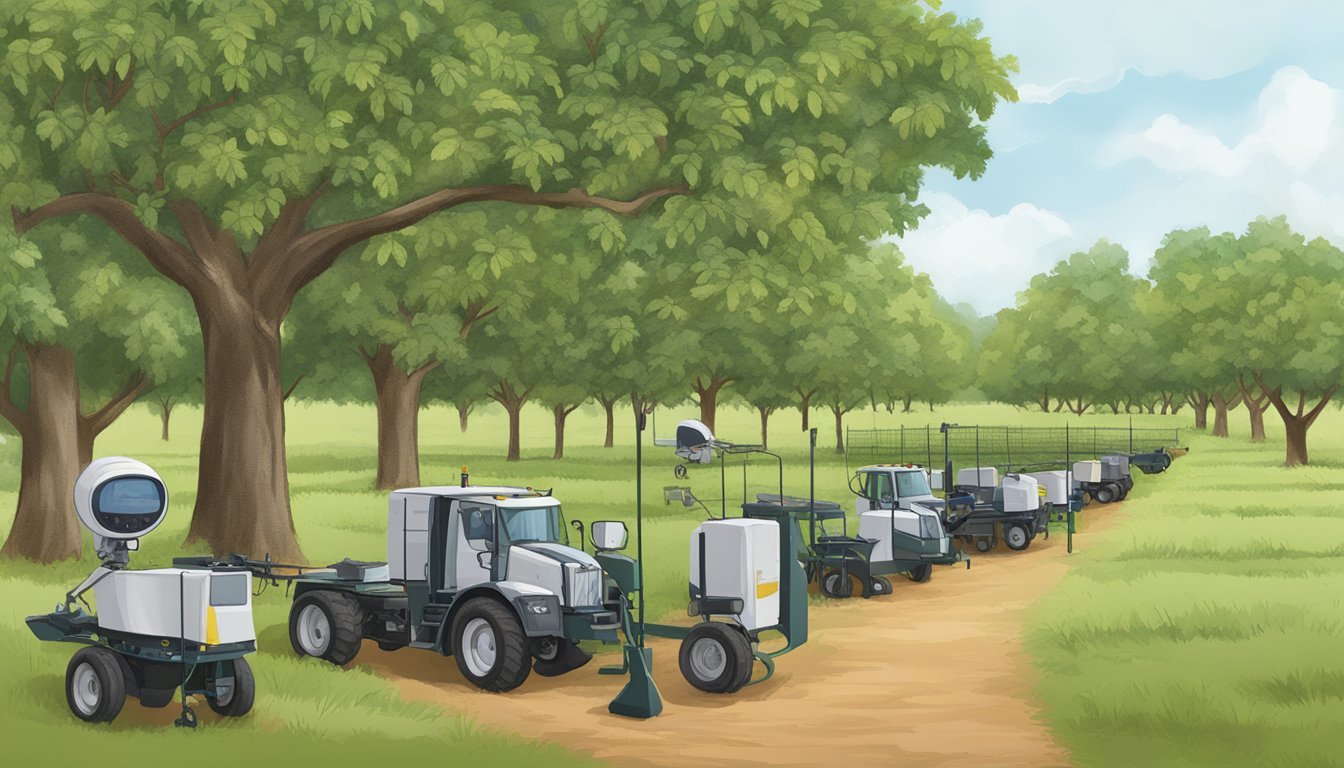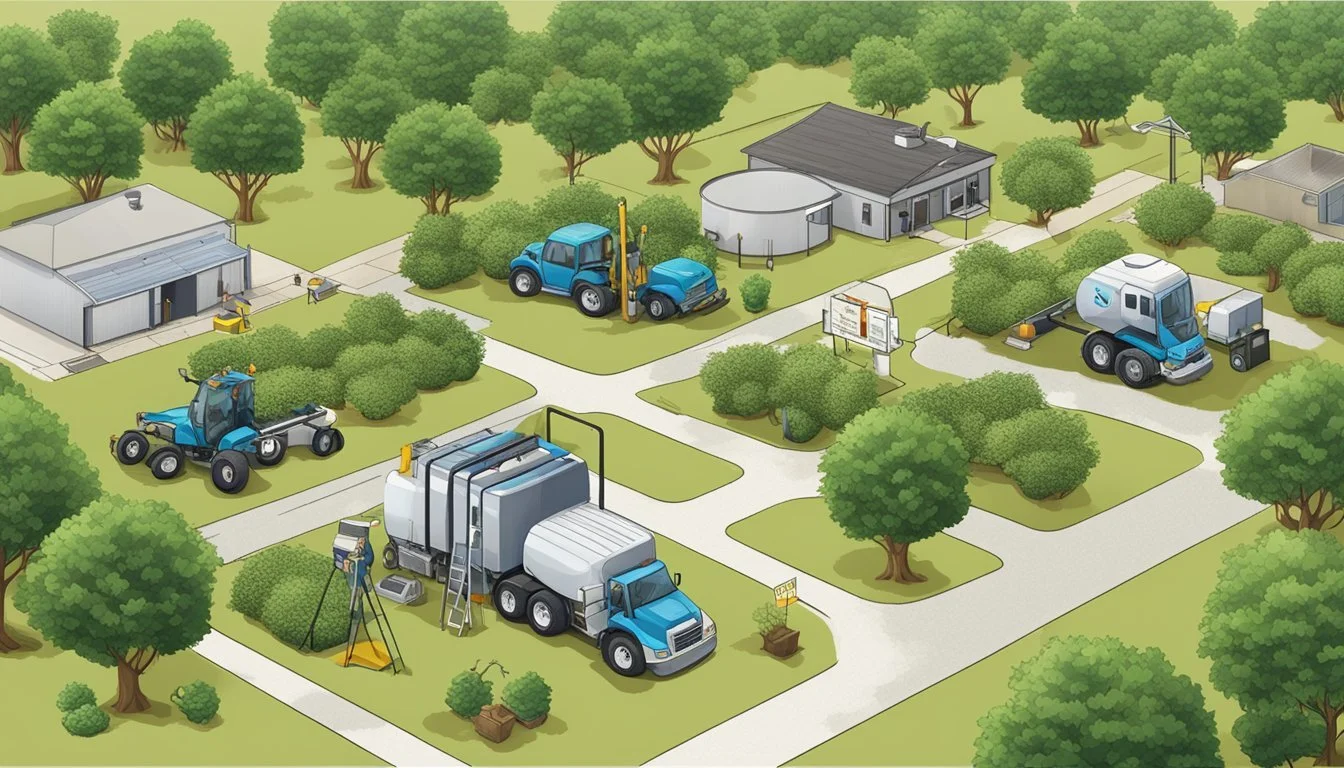Pest Control for Pecan Orchards
Essential Strategies for Healthy Trees
Pecan orchards face numerous challenges, but one of the most persistent and damaging is the threat of pests. Insects and mites can have a profound impact on pecan production, both by directly feeding on the nuts (What wine goes well with nuts?) and by weakening the trees to reduce future yields. Effective pest control is therefore crucial for maintaining the health of pecan trees and ensuring the profitability of the pecan industry. With a variety of insects such as aphids, weevils, and borers posing threats to pecan trees, orchard owners must be well-versed in pest management strategies.
Effective control of pests in pecan orchards involves an integrated approach that includes routine monitoring for early detection of infestations, application of cultural practices to deter pest colonization, and, when necessary, the use of chemical pesticides. It is important for growers to identify the pests that are most common in their region, understand their life cycles, and be aware of the most vulnerable stages of the pecan tree. Utilizing pheromone traps and instituting biological controls are also key components of a successful pest management program.
Tailoring pest control methods to the specific needs of each orchard allows for more efficient and sustainable management. Implementing timely interventions can significantly mitigate nut losses due to insects and diseases. Consequently, a well-planned pest control strategy serves as the foundation for both the short-term quality and long-term viability of pecan orchards.
Pecan Orchard Ecosystem
The health of a pecan orchard ecosystem is crucial for productive pecan trees. This includes a keen focus on the interactions among plants, soil, and water, the role of beneficial insects, and the impact of wildlife and biodiversity.
Plant-Soil-Water Interactions
The foundation of a pecan orchard ecosystem lies within its plant-soil-water interactions. Pecan trees thrive on a delicate balance; the soil quality influences water retention and nutrient availability. Soil rich in organic matter from the breakdown of leaves enhances the soil structure, which in turn improves the water-holding capacity vital for pecan tree growth and nut development.
Role of Beneficial Insects
Beneficial insects play a pivotal role in maintaining the health of pecan orchards. Pests are managed through biological control by conserving natural predators and using selective pesticides that target pests without harming beneficial species. For example, lady beetles are instrumental in controlling aphid populations, leading to a more stable orchard environment.
Wildlife and Biodiversity
A diverse wildlife presence contributes to a healthier pecan orchard ecosystem. Various species serve as natural guardians by controlling pests and creating a sustainable environment. The presence of birds, for instance, can mitigate insect infestations, while the biodiversity within the orchard floor vegetation supports ecological stability and resilience.
Understanding Pecan Pests
Effective pest management in pecan orchards is crucial for the prevention of crop damage and economic loss. Understanding the diversity and life cycles of pecan pests, including insects and diseases, enables growers to implement timely and efficient control strategies.
Lifecycle of Pecan Pests
The life cycle of pecan pests typically includes an egg stage, larval stages, and adult stages. Some, like the pecan weevil, lay their eggs inside the nut, where the developing larvae feed on the kernel before emerging. Other pests, such as aphids, may reproduce multiple times within a single season, rapidly increasing pest pressure in the orchard.
Common Pecan Insects and Diseases
Pecan orchards can be affected by various insects and diseases, each causing unique damage. Insects such as the hickory shuckworm and pecan phylloxera directly harm the nuts and foliage, respectively. Meanwhile, diseases often follow insect activity, exploiting the weakened state of the trees. The yellow pecan aphid, a common pest, sucks sap from leaves, and while not lethal, can reduce tree vigor and nut quality.
Late-Season Pecan Pest Dynamics
As the season progresses, certain pests become more active and problematic. Late-season pests like mites, which may appear as bronzed, scorched areas on the undersides of leaflets, require attention as they can cause significant damage if left unmanaged. Furthermore, defoliating caterpillars such as the fall webworm and walnut caterpillar can strip trees of leaves, affecting nut maturation and overall tree health.
Pest Monitoring and Identification
Effective pest management in pecan orchards begins with meticulous monitoring and accurate identification of pests. These initial steps are crucial for implementing timely and appropriate control measures.
Scouting Techniques
Scouting is the regular and systematic checking of pecan trees for signs of pests. An essential method is the use of pheromone traps which are strategically placed to detect the presence of pests like the pecan nut casebearer, indicating potential infestations. These traps help to pinpoint when the adults are active and the hatching period of larvae is likely to occur. Regular orchard walks are advised to check for nut drop, black frass, and other signs that indicate pest activity. Observing the silk stage of growth can alert growers to the risk period for the pecan nut casebearer and other pests.
Pest Identification Guide
Accurate identification of pecan pests is foundational to successful management. The pecan nut casebearer, for instance, is a gray moth in its adult form, and control measures are often targeted towards the larvae that are greenish-white with a brown head. Full-grown larvae indicate a mature infestation, while finding white eggshells attached to nuts is a sign of recent egg-laying activity. It's important to distinguish beneficial insects from pests, ensuring that beneficial population is not inadvertently reduced through pest control actions.
Monitoring Pecan Pests
Monitoring involves detailed observations and recording pest populations over time. Research into the biology of pests such as the pecan nut casebearer facilitates the creation of predictive models and monitoring programs. Such programs track the lifecycle of the pests, including their overwinter phases and timing for when they pupate. Pecan growers can refer to guides like the Commercial Pecan Spray Guide from UGA Cooperative Extension for year-specific pest management recommendations. Effective monitoring blends historical data with current observations to predict pest outbreaks and guide the application of control measures.
Cultural and Biological Control Strategies
In managing pests within pecan orchards, it is imperative to focus on cultural and biological control strategies that emphasize habitat management, utilization of natural predators and parasites, and the integration of these methods into broader Integrated Pest Management (IPM) programs.
Habitat Management
Habitat management involves modifying the orchard environment to reduce the incidence of pests while promoting beneficial organisms. Strategies such as choosing adapted pecan varieties that thrive in the local climate can preemptively decrease pest challenges. Ensuring that orchards have moist and fertile soil helps maintain healthy pecan trees less susceptible to pest attacks.
Natural Predators and Parasites
Conservation of natural enemies in the orchard is an essential component of biological control. This includes fostering a population of predators like spiders, lacewings, lady beetles, and assassin bugs. Additionally, parasitic insects can effectively control pest populations. Practices such as augmentation, which is the periodic release of these beneficial organisms, can be employed to bolster their numbers and impact.
Integrated Pest Management Integration
Integrating cultural and biological strategies into an IPM approach enhances pest control within orchards. This requires a deep understanding of pest and predator life cycles and interactions to time interventions effectively. Research is focusing on the combination of chemical, biological, and cultural practices to optimize pecan production and pest management. Monitoring the biodiversity of orchards via traps and other methods is key to understanding and improving these integrated systems.
Chemical Control and Pesticide Management
Effective pest control in pecan orchards often involves chemical solutions. Choosing the right insecticides and understanding labels, as well as managing potential drift and non-target effects, are all critical components in safeguarding the crop and the environment.
Insecticide Selection and Usage
Selecting the appropriate insecticide is a critical decision in pecan pest management. Pecan growers must consider the targeted pest, the impact on non-target organisms, and the potential for resistance development. For instance, pyrethroids are a common choice due to their effectiveness against a variety of pests, while organophosphates such as chlorpyrifos may be selected for their broad-spectrum control. However, growers should be careful with organophosphates due to concerns about human toxicity and environmental impact. Another common insecticide, carbaryl, is known for its efficacy but must be used judiciously to minimize risks of poisoning and residues.
Understanding Pesticide Labels
Pesticide labels are not merely suggestions; they are legal documents outlining the correct use of the product. Every label provides crucial information on the active ingredient, product name, application rates, timing, and safety precautions. For example, labels will specify if an insecticide like chlorpyrifos is restricted and outline the necessary personal protective equipment to reduce the risk of poisoning. It is imperative that growers read and comply with all label instructions to ensure effective and responsible pesticide use.
Pesticide Drift and Non-Target Effects
Pesticide drift can lead to unintended consequences, such as poisoning of non-target species and contamination of neighboring habitats. To prevent drift, applicators must consider weather conditions, equipment settings, and formulation type. Avoiding application during strong winds and using drift-reducing technologies are recommended practices. It is also important to understand the implications of pesticide residues for human and environmental health and work proactively to minimize adverse effects.
Pest Management in Pecan Production
Effective pest management in pecan orchards is essential for protecting the trees and ensuring a healthy crop yield. Critical considerations include the balance of nutrients, careful water management, and vigilant pest control throughout various growth stages, all of which are influenced by weather conditions and can affect factors such as sap flow and pollination.
Fertilization and Nutrient Management
Proper fertilization is paramount for pecan trees to develop strong shells and resist pests. They require a specific blend of nutrients for optimal growth and nut production. Essential nutrients include nitrogen, zinc, and phosphorus. An imbalance can make trees more susceptible to diseases and pests.
Nitrogen: Vital for leaf and branch growth; apply in the spring.
Zinc: Critical for leaflet development; apply zinc sulphate before bud break.
Phosphorus: Encourages root development; apply based on soil test results.
Irrigation and Water Management
Pecan trees demand consistent and adequate irrigation for healthy growth, which also aids in disease prevention. Drip or micro-spray systems are recommended to maintain ideal soil moisture levels, especially during critical sap-flow periods.
Maintain consistent soil moisture; avoid water stress.
Irrigation schedule adjustments may be necessary based on weather conditions.
Pest Control During Critical Growth Stages
Pests are most threatening during key development stages of pecans. Integrated Pest Management (IPM) strategies help control pests while maintaining ecological balance.
Pollination stage: Protect from pests like aphids that can affect pollination.
Nut development: Apply insecticides to combat the pecan weevil, which feeds on the nut's kernel.
Pre-harvest: Monitor for stink bugs that can penetrate the shell and damage the kernel.
Control measures should be carefully timed, considering the pecan's vulnerable growth periods and local weather patterns to maximize their effectiveness.
Advanced Topics in Pest Control
The adoption of advanced pest control strategies is essential for mitigating losses and promoting sustainable practices in pecan orchards. This section delves into the latest research findings, regulatory frameworks, and innovative approaches that are shaping the future of pecan pest management.
Research Updates and Findings
Recent studies have shed light on the relationship between pecan insect pests and orchard ecosystem health. For instance, research has emphasized the importance of integrated pest management (IPM) in effectively combating pests like the pecan weevil, a prevalent pest throughout most of Texas. Recommendations include site-specific practices that not only target the pest but also consider environmental impact, aiming to reduce chemical residues. The Georgia Cooperative Extension's Commercial Pecan Spray Guide reinforces these principles, offering tailored guidance reflective of the latest research and improved varieties of pecans.
Policy and Regulatory Considerations
The Texas Department of Agriculture, responsible for overseeing pest control measures in the state’s pivotal pecan industry, has a vital role in implementing policy statements on pest management. This encompasses establishing thresholds for chemical applications to minimize residues and safeguarding consumer health. At the same time, it is imperative that growers stay informed of any changes in policy to remain compliant and ensure their pest control methods are not only effective but also legally sound.
Pest Management Innovations
Innovation in pest management strategies can lead to significant money savings for growers. Implementation of cover crops is one such innovation; they can bolster the ecosystem's health and deter pests. Additionally, pioneering tools like pheromone traps and predictive models have been developed to aid in the precise timing of pest control actions. This precision reduces unnecessary applications and costs, highlighting the practical suggestions from entities such as the Managing Insect and Mite Pests of Commercial Pecans in Texas guide and underscoring the value of reliable and cutting-edge techniques in pest management.
Frequently Asked Questions
Managing pests in pecan orchards is critical for ensuring the health of the trees and the quality of the crop. These frequently asked questions cover effective methods and best practices for controlling common pests and diseases that can affect pecan orchards.
What is the most effective method for controlling weevils in pecan trees?
The most effective method for controlling weevils in pecan trees includes regular monitoring and the timely application of insecticide sprays during the growing season to target the pecan weevil.
What natural strategies are recommended for managing pests in pecan orchards?
Natural strategies for managing pests in pecan orchards involve integrated pest management (IPM) approaches, such as using resistant varieties, employing pheromone traps, and encouraging beneficial predators to control pest populations.
How can pecan phylloxera infestations be prevented or treated?
To prevent or treat pecan phylloxera infestations, orchard managers should consider applying dormant oil sprays to kill overwintering eggs and use targeted insecticides during the growing season once the presence of pests is confirmed.
What are the common signs of disease in pecan trees, and how can these diseases be managed?
Common signs of disease in pecan trees include leaf discoloration, cankers, and shuck decline. Management of these diseases typically requires the removal of infected material and application of appropriate fungicides when necessary.
What are the best practices to deter squirrels from invading pecan orchards?
Best practices to deter squirrels from invading pecan orchards include the use of physical barriers such as nets or fences and habitat modification to reduce nesting sites and food sources near the orchards.
How should a pecan orchard be maintained to minimize pest issues?
To minimize pest issues, a pecan orchard should be properly maintained by ensuring good agricultural practices like regular monitoring, timely pruning, strategic irrigation, and soil management to promote healthy trees that are less susceptible to pests and diseases.





